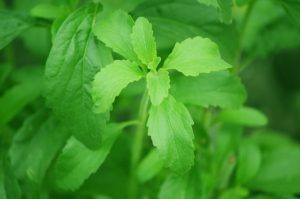 Stevia (Stevia rabaudiana) is an herb natural to Brazil and Paraguay, where the native Guarani people have used it for thousands of years to sweeten their mate, an infusion of yerba mate leaves and hot water served in a hollowed calabash gourd and drank through a straw. They also used it in medicine and as a sweet treat. Stevia can be found now around the world, although the best stevia is still found in South America.
Stevia (Stevia rabaudiana) is an herb natural to Brazil and Paraguay, where the native Guarani people have used it for thousands of years to sweeten their mate, an infusion of yerba mate leaves and hot water served in a hollowed calabash gourd and drank through a straw. They also used it in medicine and as a sweet treat. Stevia can be found now around the world, although the best stevia is still found in South America.
Since stevia is many times sweeter than sugar and it does not raise blood sugar levels, modern science has adopted it as a favourite sweetener, which is used in many industries. Unfortunately, the synthetic powder that can be found in supermarkets and is used to sweeten soft drinks, is detrimental to human health. It is far from “natural” as it is highly processed and bleached and it contains other man-made chemicals.
On the other hand, nature, as always, has the perfect solution. In fact, you can raise stevia plants from seeds every summer in pots that can be kept inside over the winter, like I do. You can use the fresh leaves or you can buy the dried leaves, grind them yourself and add them to your favourite herbal tea blend or other beverages, so that you can enjoy a sweet drink without the bitter aftertaste of the chemical stuff, but be careful with the amounts you use because just a tiny bit can be extremely sweet!
At home, I make my own stevia water, which can also be used in any recipe, by simply mixing some stevia leaves with hot water (but not boiling hot). I let it cool to room temperature, strain it, and store it in the fridge.
Natural stevia lets you enjoy the sweetness of nature without the side effects of sugar and other chemical sweeteners.
Herbs for health